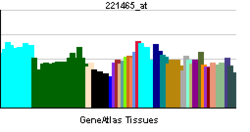- OR6A2
-
Olfactory receptor, family 6, subfamily A, member 2 Identifiers Symbols OR6A2; I7; MGC126538; MGC126540; OR11-55; OR6A1; OR6A2P External IDs OMIM: 608495 MGI: 97432 HomoloGene: 2743 GeneCards: OR6A2 Gene Gene Ontology Molecular function • molecular_function
• receptor activity
• olfactory receptor activityCellular component • plasma membrane
• integral to membraneBiological process • signal transduction
• sensory perception of smell
• response to stimulusSources: Amigo / QuickGO RNA expression pattern 
More reference expression data Orthologs Species Human Mouse Entrez 8590 18317 Ensembl ENSG00000184933 ENSMUSG00000070417 UniProt O95222 n/a RefSeq (mRNA) NM_003696 NM_010983.2 RefSeq (protein) NP_003687 NP_035113.1 Location (UCSC) Chr 11:
6.82 – 6.82 MbChr 7:
114.14 – 114.15 MbPubMed search [1] [2] Olfactory receptor 6A2 is a protein that in humans is encoded by the OR6A2 gene.[1]
Olfactory receptors interact with odorant molecules in the nose, to initiate a neuronal response that triggers the perception of a smell. The olfactory receptor proteins are members of a large family of G-protein-coupled receptors (GPCR) arising from single coding-exon genes. Olfactory receptors share a 7-transmembrane domain structure with many neurotransmitter and hormone receptors and are responsible for the recognition and G protein-mediated transduction of odorant signals. The olfactory receptor gene family is the largest in the genome. The nomenclature assigned to the olfactory receptor genes and proteins for this organism is independent of other organisms.[1]
Contents
See also
References
Further reading
- Buettner JA, Glusman G, Ben-Arie N et al. (1998). "Organization and evolution of olfactory receptor genes on human chromosome 11". Genomics 53 (1): 56–68. doi:10.1006/geno.1998.5422. PMID 9787077.
- Lane RP, Cutforth T, Young J et al. (2001). "Genomic analysis of orthologous mouse and human olfactory receptor loci". Proc. Natl. Acad. Sci. U.S.A. 98 (13): 7390–5. doi:10.1073/pnas.131215398. PMC 34679. PMID 11416212. http://www.pubmedcentral.nih.gov/articlerender.fcgi?tool=pmcentrez&artid=34679.
- Strausberg RL, Feingold EA, Grouse LH et al. (2003). "Generation and initial analysis of more than 15,000 full-length human and mouse cDNA sequences". Proc. Natl. Acad. Sci. U.S.A. 99 (26): 16899–903. doi:10.1073/pnas.242603899. PMC 139241. PMID 12477932. http://www.pubmedcentral.nih.gov/articlerender.fcgi?tool=pmcentrez&artid=139241.
- Malnic B, Godfrey PA, Buck LB (2004). "The human olfactory receptor gene family". Proc. Natl. Acad. Sci. U.S.A. 101 (8): 2584–9. doi:10.1073/pnas.0307882100. PMC 356993. PMID 14983052. http://www.pubmedcentral.nih.gov/articlerender.fcgi?tool=pmcentrez&artid=356993.
- Gerhard DS, Wagner L, Feingold EA et al. (2004). "The Status, Quality, and Expansion of the NIH Full-Length cDNA Project: The Mammalian Gene Collection (MGC)". Genome Res. 14 (10B): 2121–7. doi:10.1101/gr.2596504. PMC 528928. PMID 15489334. http://www.pubmedcentral.nih.gov/articlerender.fcgi?tool=pmcentrez&artid=528928.
External links
This article incorporates text from the United States National Library of Medicine, which is in the public domain.
Class II
(tetrapod specific receptors)Family 1Family 2A1 · A2 · A4 · A5 · A7 · A12 · A14 · A25 · A42 · AE1 · AG1 · AG2 · AJ1 · AK2 · AP1 · AT4 · B2 · B3 · B6 · B8 · B11 · C1 · C3 · D2 · D3 · F1 · F2 · G2 · G3 · G6 · H1 · H2 · J1 · J2 · J3 · K2 · L2 · L3 · L5 · L8 · L13 · M2 · M3 · M4 · M5 · M7 · S2 · T1 · T2 · T3 · T4 · T5 · T6 · T8 · T10 · T11 · T12 · T27 · T29 · T33 · T34 · T35 · V1 · V2 · W1 · W3 · W5 · Y1 · Z1
Family 3Family 4Family 5Family 6Family 7Family 8Family 9Family 10Family 11Family 12Family 13Categories:- Human proteins
- Transmembrane receptor stubs
- G protein coupled receptors
Wikimedia Foundation. 2010.
